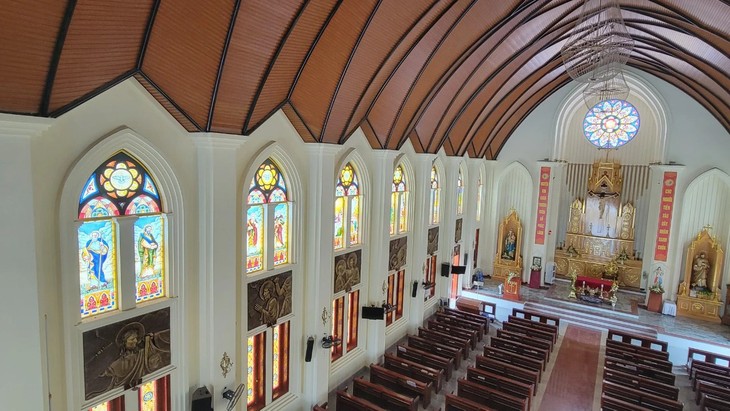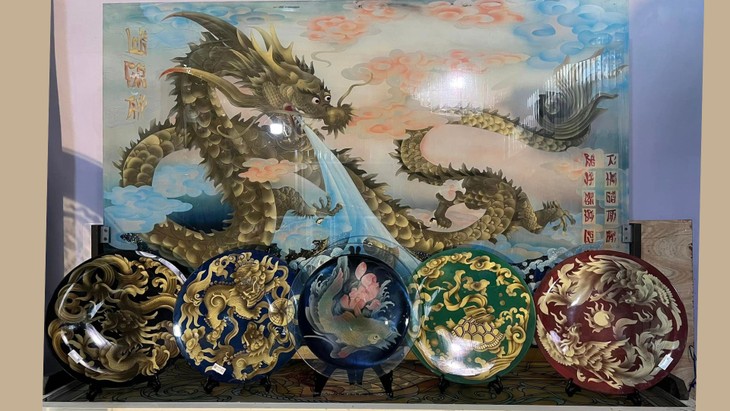Vinh said he received a patent for a new type of glass painting from the Intellectual Property Office. Unlike traditional glass painting, his method sculpts the glass using 3D engraving techniques. After the glass goes through a tempering furnace, it becomes ten times harder. The artwork uses ceramic enamel fired at 700 degrees Celsius, and in special cases, it can be fired up to 850 degrees Celsius. This process makes the glass paintings extremely durable.
"What I mean by my glass paintings being super durable is that they can handle extreme force like being hit with rocks or sledgehammers. Layering two or three pieces of tempered glass makes them bulletproof," he said, adding that the ceramic color only fades if the glass is abraded, and it resists UV rays, humidity, and the tropical climate in Vietnam.
"It also withstands chemicals, acids, and alkalis. There’s no limit to how long this tough glass can last," Vinh said.
 Vinhcoba's glass paintings are used in a church in Hai Phong city Vinhcoba's glass paintings are used in a church in Hai Phong city |
Vinh named himself and his glass paintings "Vinhcoba," combining his name with a term used in Ho Chi Minh City to describe a beautiful woman of good virtue. Creating a glass painting is a complex process. Vinh and his team at COBA Art Glass JSC follow a meticulous eight-step procedure that includes design, engraving, painting, and tempering the glass in a kiln. They adhere to strict rules of perspective, light, and shadow to achieve a vivid quality.
The first step is drawing on paper. Vinh portrays architecture, people, and daily life in his glass paintings to help preserve Vietnam’s national identity and inspire a deeper love for the homeland.
As the creator of glass paintings in Vietnam, Vinh has infused Vietnamese culture into most of my pieces from the start. "This cultural essence flows through my art – lotus flowers, chrysanthemums, traditional ceramic patterns, and depictions of national heroes like President Ho Chi Minh, General Vo Nguyen Giap, and recently, Party General Secretary Nguyen Phu Trong," he said.
 Vinhcoba's painting of dragons from the 11th-century Ly Dynasty. Vinhcoba's painting of dragons from the 11th-century Ly Dynasty. |
Vinh says his favorite piece is a painting of dragons from the 11th-century Ly Dynasty, when the dragon became a symbol of royalty. In Vietnam, the dragon is a sacred symbol, tied to the legend in which the Vietnamese people are descendants of a dragon and a fairy. Though mythical, dragons are seen as powerful and deeply connected to Vietnamese history.
This painting was inspired by Vinh’s visit to Bai Dinh pagoda in Ninh Binh province, where he saw five-fingered dragons carved into the four stone pillars at the pagoda's gate, curling gracefully in water.
The Ly Dynasty dragon has large, rough scales, a flaming crest, a smooth, slender body, and a gently winding shape. Vinh added two lines of poetry: ‘Vietnam makes friends with neighboring countries to live in peace, and the Golden Dragon will forever reign over the East Sea.’ This message is meant to remind island soldiers that part of the East Sea belongs to Vietnam and the sacred dragon will always protect them.
Bui Hai Ha, who has been working in this field for over 20 years, said she can’t fully explain the immense joy she feels when creating lotus glass paintings. She said the lotus flower symbolizes ascension, representing the Buddhist journey through three thousand realms of existence.
"I love blending colors from the mud and water layers to the stem, leaves, and blue sky. Lotus paintings are often ordered for worship rooms, with some customers choosing blue or brown-yellow hues for feng shui."
Ha entered this profession out of curiosity, initially wondering how she could carve not just wood and stone but also this unique material. In the early days of learning from Vinh, her hands often bled, but she persevered. After ten years of dedication, she finally felt confident in creating her work and mentoring young colleagues.
However, she still considers sculpting/engraving in a confined space to be a challenge. The technique uses compressed air to shoot small particles of sand through a hose to erode the granite surface.
In the sculpting room, the air is thick with dust, so the artisan wears protective suits and old Soviet gas masks which has been used for the past 35 years.
"The mask has a breathing tube for clean air and a cooling tube, while keeping the sand out. Since it's hard to see while sculpting, I use my hands to feel the depth and texture of the sand on the transparent material," Ha said.
To achieve the most realistic colors on transparent panels, the artwork must be fired multiple times, which can lead to explosions and breakages. Flattening the material is challenging enough, but shaping it into various forms often results in significant breakage. Vinh notes that these failures are simply part of the price of success.
"Honestly, it feels like a mountain of broken pieces, and the sound of shattering panels can be quite disheartening. As my old teacher once said, this profession is like a trial by fire: it turns out either as gold or as coal. But when we finally create a complete piece, the satisfaction is beyond words."
Vinh’s workshop houses a giant cloud-shaped gong, made not from bronze or iron, but from glass. And the sound is strikingly similar to that of bronze or iron.
|
Vinhcoba's glass cloud-shaped gong
|
Vinh used two large drumsticks to strike the transparent gong, which is often displayed in Buddhist worship places. The gong is an important Buddhist instrument, used in chanting and significant ceremonies.
Vinh and his team not only create original transparent panel paintings but have restored deteriorated and broken stained panel artworks in 30 pagodas across Vietnam.
In addition to being displayed in worship places, Vinh's creations are used for interior and exterior decoration of private homes, and sold as gifts. He crafts night lights adorned with Dong Ho folk motifs and mirrors and decorative plates featuring the twelve signs of the zodiac.
Luong Dinh Tuan, a fan of glass painting, said he has many decorative items at home. “I especially like lotus partitions, glass lamps, and glass fruit stands, which are a fresh and appealing alternative to ceramic products. Glass paintings from abroad are often made by assembling pieces of colored glass. They’re not durable. By contrast, Vietnamese glass paintings are handcrafted by skilled Vietnamese artisans to be durable, a quality I greatly appreciate,” said Tuan.
Vinh’s team has perfected the production of tempered glass, which can replace iron, steel, wood, and concrete in doors, ceilings, floors, roofs, and household items like cutting boards, plates, beds, and cabinets. Tempered glass is also used in architectural panels, including double-glazed panels for soundproofing and heat insulation, super-tempered glass for bulletproofing, and sky-high glass bridges that safely support thousands of people.
Vinh began this journey not solely to fulfill his own passion. At 63, this artisan always envisions this art form with hope.
"This is just the start, opening a door to this unique form of painting. Future generations of Vietnamese artists will carry on and evolve Vinhcoba's glass art, creating even more distinctive and beautiful sculptures.”